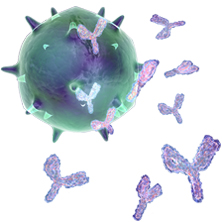Gupta P, Patel DK, Gupta VK, Pal A, Tandon S, Darokar MP Phytomedicine, 2017 BACKGROUND: Staphylococcus aureus (SA), is a major human pathogen causing wide range of clinical infections, which has been further complicated by drug resistance like methicillin resistant S. aureus (MRSA), vancomycin intermediate S. aureus (VISA)/vancomycin resistant S. aureus (VRSA), etc. The present… Read more »

This system includes the lymph nodes, white blood cells, lymphatic vessels, thymus gland, bone marrow, spleen and leukocytes. Common disorders include anything with bacterial, viral or fungal origins, leukemia, allergic reactions and autoimmune diseases like lupus or rheumatoid arthritis.
Evaluation of active ingredients and larvicidal activity of clove and cinnamon essential oils against Anopheles gambiae (sensu lato)
Thomas A, Mazigo HD, Manjurano A, Morona D, Kweka EJ Parasites & Vectors, 2017 BACKGROUND: Mosquitoes are well-known vectors of many diseases including malaria and lymphatic filariasis. Uses of synthetic insecticides are associated with high toxicity, resistance, environmental pollution and limited alternative, effective synthetic insecticides. This study was undertaken to evaluate the larvicidal efficacy of… Read more »
As an Adjunct to Mechanical Oral Hygiene, Essential Oil-containing Mouthwash, Compared to Floss, Cetylpryidinium Chloride, or Placebo may be more Effective in Reduction of Plaque and Gingitivitis
Tilliss T, Carey CM Journal of Evidence Based Dental Practice, 2017 ABSTRACT: The question being studied by this systematic review of the literature is how mouthwashes containing essential oils used as adjuncts to daily mechanical plaque control compare to placebo mouthwashes, cetylpyridinium chloride (CPC), or dental floss in reducing plaque and gingivitis among adults with gingivitis…. Read more »
In Vitro Efficacy of Essential Oil Mouthrinse versus Dentifrices
Serbiak B, Fourre T, Geonnotti AR, Gambogi RJ Journal of Dentistry, 2017 OBJECTIVES: To compare the antimicrobial efficacy and kill penetration of essential oils (EO) mouthrinse versus stannous fluoride, and triclosan dentifrice slurries on saliva-derived biofilms using confocal laser scanning microscopy (CLSM). METHODS: Saliva-derived biofilms were grown for 48hours on hydroxyapatite discs using pooled, homogenized… Read more »
Chemical composition, enantiomeric analysis, AEDA sensorial evaluation and antifungal activity of the essential oil from the Ecuadorian plant Lepechinia mutica Benth (Lamiaceae)
Ramírez J, Gilardoni G, Jácome M, Montesinos J, Rodolfi M, Guglielminetti ML, Cagliero C, Bicchi C, Vidari G Chemistry & Biodiversity, 2017 ABSTRACT: This study describes the GC-FID, GC-MS, GC-O, and enantioselective GC analysis of the essential oil hydrodistilled from leaves of Lepechinica mutica (Lamiaceae), collected in Ecuador. GC-FID and GC-MS analyses allowed the characterization and quantification… Read more »
A Review on Influencing Factors on the Minimum Inhibitory Concentration of Essential Oils
Van de Vel E, Sampers I, Raes K Critical Reviews in Food Science and Nutrition, 2017 ABSTRACT: With growing interest in essential oils as natural preservatives in the food industry, the literature is expanding enormously. To understand the antimicrobial activity of essential oils, the antimicrobial mechanism of individual essential oil (EO) compounds, and their minimum inhibitory concentrations… Read more »
Carvacrol reduces Clostridium difficile sporulation and spore outgrowth in vitro
Mooyottu S, Flock G, Venkitanarayanan K Journal of Medical Microbiology, 2017 PURPOSE: Clostridium difficile is an anaerobic spore-forming pathogen that causes a serious toxin-mediated enteric disease in humans. Therapeutic agents that are capable of reducing C. difficile spore production could significantly minimize the transmission and relapse of C. difficile infections. This study investigated the efficacy… Read more »
Comparison study on antioxidant, DNA damage protective and antibacterial activities of eugenol and isoeugenol against several foodborne pathogens
Zhang LL, Zhang LF, Xu JG, Hu QP Food and Nutrition Research, 2017 ABSTRACT: Eugenol and its isomer isoeugenol are both used as flavouring agents or food additives in food products, and have both some similar biological properties. However, the difference in biological activities between eugenol and isoeugenol is rarely studied. In this study, the profiles of antioxidant,… Read more »
Update on Monoterpenes as Antimicrobial Agents: A Particular Focus on p-Cymene
Marchese A, Arciola CR, Barbieri R, Silva AS, Nabavi SF, Tsetegho Sokeng AJ, Izadi M, Jafari NJ, Suntar I, Daglia M, Nabavi SM Materials, 2017 ABSTRACT: p-Cymene [1-methyl-4-(1-methylethyl)-benzene] is a monoterpene found in over 100 plant species used for medicine and food purposes. It shows a range of biological activity including antioxidant, anti-inflammatory, antinociceptive, anxiolytic, anticancer… Read more »
Synergistic interaction of ten essential oils against Haemonchus contortus in vitro
Katiki LM, Barbieri AME, Araujo RC, Veríssimo CJ, Louvandini H, Ferreira JFS Veterinary Parasitology, 2017 ABSTRACT: Anthelmintic resistance in sheep gastrointestinal nematodes is a worldwide problem. Multi-drug resistant haemonchosis is the most serious impediment for small ruminant systems, and there are no new drug candidates currently under development. Molecules from natural sources have demonstrated anthelmintic… Read more »
